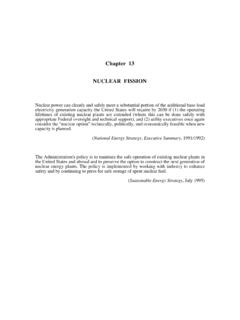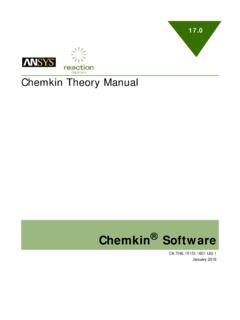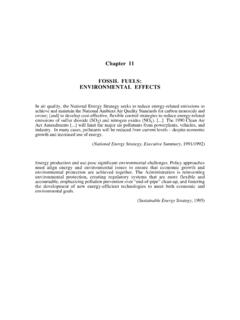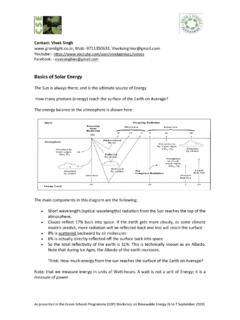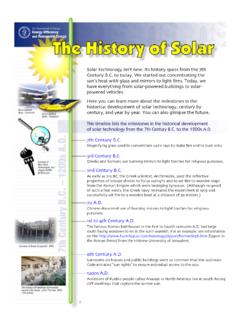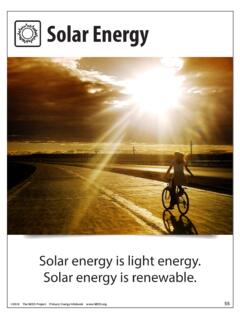Transcription of Chapter 17 SOLAR ENERGY - Pennsylvania State University
1 Chapter 17 SOLAR ENERGYR enewable technologies represent an important opportunity, but not a panacea for the economy. Their long-term contribution is predicated on overcoming remainingtechnical and cost barriers, mainly through intensified R&D. The National EnergyStrategy's renewable ENERGY initiatives are based on these conclusions and on a clearunderstanding of the contributions that renewable ENERGY can and cannot be expected tomake. For example, given policies to address existing regulatory barriers and marketimperfections, SOLAR thermal or photovoltaic electricity technologies can compete today toprovide electricity generation in remote locations and for peaking purposes.
2 (National ENERGY Strategy, Executive Summary, 1991/1992)The Administration supports fundamental and applied research that helps the renewableindustry develop technologically advanced products. [..] Applied research into thinreflective membrane deposition, airfoil design, and SOLAR module fabrication has reducedcosts and increased productivity from SOLAR thermal power plants, wind turbines, and flatplate photovoltaic arrays.[..]Programs supporting renewable electric supply will contribute quads of primary energyin the year 2000, saving $4 billion in annual fuel costs and reducing 7 million metric tonsof carbon-equivalent emissions.
3 (Sustainable ENERGY Strategy, 1995)314 Chapter 17In Chapter 16 we discussed the following nondepletable ENERGY sources: geothermal, wind,tidal, wave, hydroelectric and biomass ENERGY . We saw that they will not solve the world'senergy problems. But they are, they can be and they will be important on a local scale. InChapter 14 we discussed nuclear fusion; it could solve all our ENERGY problems, but manytechnical problems need to be overcome before it can be harnessed and production of electricity using fusion must go through the bottleneck of thermal-to-mechanical ENERGY conversion, which is inherently inefficient.
4 The last ENERGY source thatwe need to discuss, direct SOLAR ENERGY , will solve all society's ENERGY problems, but notyet. Its efficient large-scale utilization is expected to become a reality some time in the 21stcentury (probably in the second half). Its greatest virtue apart from being free,inexhaustible, universally available and pollution-free is that it can be converted directlyinto electricity, unlike any other ENERGY source. Its potential, its current status and thechallenges lying ahead are discussed ENERGY BalanceMore than of the ENERGY flow on the earth's surface is due to incoming solarradiation.
5 The rest is from geothermal, gravitational (tidal) and nuclear sources. The sun isan average-size star, with a diameter of 864,000 miles and 93 million miles away from ourplanet. It is a giant nuclear fusion reactor whose interior and surface temperatures are35,000,000 and 10,000 F, respectively. Each second 657 million tons of hydrogenisotopes are converted into 653 million tons of helium. The residual mass of 4 million tonsis converted to ENERGY , according to the Einstein equation, E = mc2:Power from the sun = (4x109 kgs) (3x108 ms)2 = WTo place this number into perspective, if gasoline were pouring from Niagara Falls, at arate of 5 billion gallons per hour, and if we had begun collecting it million years ago,the combustion of all this accumulated gasoline would liberate the amount of energyequivalent to one minute of the sun's production.
6 The reader is urged to verify quite far away from the sun, the earth receives only about half a billionth of thisradiation. But it receives it more or less continuously. About 30% of this ENERGY does notreach the surface of the earth because it is reflected from the atmosphere (as ultravioletradiation, see Figures 3-1 and 11-7). Still, the radiation that does reach the surface is fourorders of magnitude larger than the total world's ENERGY consumption (see Illustration 5-1and Figure 5-2). In fact, only 40 minutes of sunshine would be sufficient if available inadequate forms to supply the entire annual ENERGY demand on if mentioned in the previous sentence is a big one, however.
7 Because SOLAR energyspreads out more or less evenly through space, it reaches the surface of the earth in quiteSOLAR ENERGY315diluted form, at a rate of about 220 W/m2 (see Figure 3-1). In other words, if one squaremeter were available for conversion of SOLAR ENERGY to electricity (at 100% efficiency), theenergy produced would be sufficient for just two or three light bulbs. The challenge ofsolar ENERGY utilization is to concentrate it. Practical ways to achieve this are discussedbelow. They include direct SOLAR heating, indirect production of electricity and directproduction of SOLAR HeatingThe use of SOLAR rays to achieve effective heating has been practiced since ancient times.
8 In213 , the Greek savant Archimedes used mirrors to direct sunlight onto the fleet ofMarcellus, the Roman general who tried to capture Syracuse (Sicily), and set his ships onfire. Today's devices are not necessarily more sophisticated than the ones used byArchimedes. They are called collectors. A collector is thus a device that collects solarradiation and converts it to thermal 17-1 shows the statistics of most recent shipments of SOLAR collectors in the low-temperature collectors are used primarily for less demanding residentialconsumption (to heat swimming pools, for example); it is good to see that their sales are upagain.
9 The medium-temperature collectors are used primarily for residential hot water. Bothkinds became popular in the decade of the oil crises (1970s). However, consumer interestin them decreased sharply when the price of oil decreased in the 1980s (see Chapter 20)and when Federal SOLAR ENERGY tax credits expired in square feetsLow-temperature collectorstMedium-temperature collectorsFIGURE 17-1. Shipment of SOLAR collectors in the [Source: ENERGY Information Administration.]316 Chapter 17 Figure 17-2 is a schematic representation of a typical flat-plate collector used for domesticheating.
10 A working fluid (such as air, water, oil or antifreeze) circulates through thetubes. The enclosure, with its black metal surface between the tubes and insulation at thebottom, is designed to maximize the absorption of SOLAR radiation and its conversion to heat:the glass cover provides the greenhouse effect. The efficiency of conversion of solarradiation to heat stored in the working fluid is a complex issue; it is quite dependent oncollector design. Man-made collectors are much less efficient than natural collectors, thatis, animal furs.



